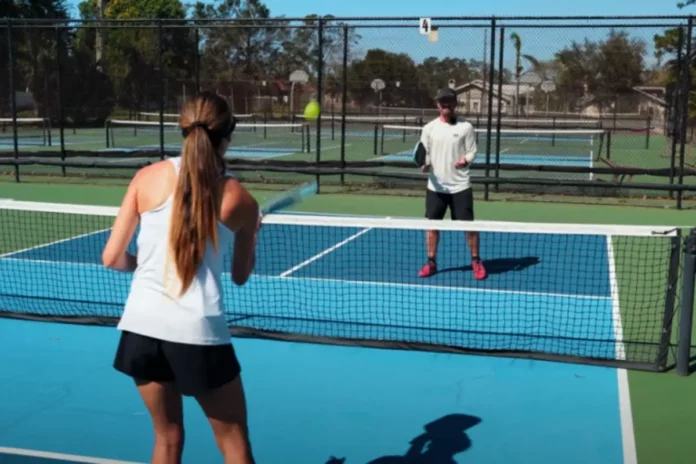Mastering Pickleball Doubles: Pickleball players of all skill levels can benefit from fundamental strategies to enhance their doubles game. Barrett and Danea provide key insights on serving, lobbing, court positioning, and more to help beginners, intermediates, and advanced players refine their techniques and increase their chances of winning matches.
Maximizing Your Pickleball Serve
Many players are too conservative with their serve, prioritizing consistency over effectiveness. While keeping the ball in play is important, a serve should also generate depth and pace. According to Barrett and Danea, adding height and spin helps create depth, making it harder for opponents to return. “The more height that you put on your serve… the deeper that ball is going to go,” they explain. When struggling to score, players should not hesitate to take risks with higher and deeper serves to gain an advantage.
Using the Lob to Gain an Edge
The lob is an underrated shot that can put opponents in difficult positions. Barrett and Danea highlight three key moments when a lob is most effective:
- When serving.
- During dinking rallies at the kitchen line.
- When disguising a lob as a dink.
A well-placed lob can disrupt an opponent’s positioning and create scoring opportunities. “If you use it more, you will frustrate your opponents and win more points,” they advise.
The Drive/Drop Combo for Net Control
Getting to the net is crucial in pickleball, and the drive/drop combination is a common strategy among professional players. Players should aim for a 60-70% effort drive with topspin to make the ball dip over the net, forcing opponents to hit upward. This sets up an easier drop shot and allows players to move forward.
Barrett and Danea describe this sequence: “You receive a return… hit a nice 60-70 percent drive… put topspin on the ball… the ball should start to dip over the net, so your opponent can’t do much with it.”
Choosing the Right Moment to Speed Up
Speeding up the ball at the right moment can put opponents on the defensive. Barrett and Danea recommend attacking when opponents are off balance, moving in a specific direction, or holding their paddle too low. The best locations to target are:
- Paddle-side shoulder (“chicken wing”).
- Paddle-side hip.
- Body (to jam opponents and limit their options).
Proper Court Positioning
Good court positioning ensures efficient coverage. Many beginners divide the court into “your side” and “my side,” but movement should be based on the ball’s location. If a shot goes wide, the closest player should cover the sideline while their partner shifts toward the middle. Coordinating movement prevents gaps and strengthens defense.
Controlling Angles in Play
Understanding angles can improve both offensive and defensive play. “Straight lines give straight lines, and angles give angles,” Barrett and Danea explain. Hitting shots down the middle reduces the opponent’s ability to create angles. If opponents are winning dinking rallies with sharp angles, players should return shots in straight lines to limit angles.
When speeding up the ball, players should target the opponent directly in front of them. Speeding up crosscourt often causes trouble for a partner instead of maintaining control.
The Takeaway
By focusing on these six strategies, players can strengthen their pickleball doubles game. Barrett and Danea emphasize the importance of effective serving, lobbing, transitioning to the net, and court positioning. Mastering these fundamentals allows players to focus on advanced tactics and improve their overall gameplay.
News in Brief: Mastering Pickleball Doubles
Pickleball experts Barrett and Danea share six key strategies to improve doubles play. They emphasize deep serves, effective lobbing, the drive/drop combo, well-timed speed-ups, strong court positioning, and controlling angles. Implementing these tactics can help players of all levels refine their game and achieve better results on the court.
ALSO READ: The Secret to Pickleball Doubles Success, Pickleball Partnerships That Click

